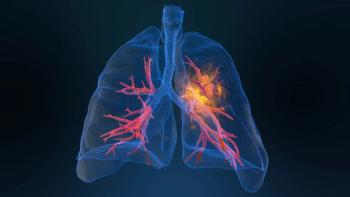
Oncology NEWS International
- Oncology NEWS International Vol 15 No 8
- Volume 15
- Issue 8
Amrubicin Appears Promising in Small-Cell Lung Cancer
In small-cell lung cancer (SCLC), a new anthracycline amrubicin demonstrated significant activity, both in patients sensitive to and refractory to previous chemotherapy
ATLANTAIn small-cell lung cancer (SCLC), a new anthracycline amrubicin demonstrated significant activity, both in patients sensitive to and refractory to previous chemotherapy, according to two studies by Japanese investigators presented at the 42nd Annual Meeting of the American Society of Clinical Oncology (abstracts 7060 and 7061).
Amrubicin is a fully synthetic anthracycline and a potent topoisomerase II inhibitor. Preclinical data have shown that amrubicin has more potent antitumor activity and is less cardiotoxic than doxorubicin. The agent, which is commercially available in Japan, is being developed in the United States by Cabrellis Pharmaceuticals Corporation (based in San Diego, California) under the brand name Calsed.
The larger of the studies (abstract 7060) was a multicenter trial of 60 previously treated SCLC patients. Patients received four cycles of amrubicin 40 mg/m2/d by IV bolus on days 1 to 3, every 3 weeks.
Takashi Seto, MD, and his colleagues from the Thoracic Oncology Research Group, Kanagawa, Japan, reported that the overall response rate was 52% for the 44 chemosensitive patients, and 50% for the 16 refractory patients. Median time to progression was 4.2 and 2.9 months, respectively, while median survival time was 11.6 and 10.3 months. One-year survival was 45.5% and 40.3%, respectively, for an overall 44.1% survival rate.
Grade 3-4 hematologic toxicity included neutropenia (83%), anemia (33%), and thrombocytopenia (20%). No treatment-related deaths occurred.
Dose Reduction
The other phase II trial (abstract 7061), led by Terufumi Kato, MD, of the National Cancer Center Hospital, Tokyo, produced similar outcomes. The study included 34 previously treated patients who were given up to six cycles of amrubicin 45 mg/m2/d on days 1 to 3 every 3 weeks. In this study, a high level of toxicity was observed, which necessitated dose reductions in 52% of patients who received two cycles or more. These patients received 35 to 40 mg/m2 after cycle 2.
Among the 34 treated patients, 4 complete responses and 14 partial responses were observed, yielding a response rate of 52.9%. Median survival was 9.2 months; survival duration was 10.4 months for patients with sensitive relapse and 6.8 months for refractory patients. One-year survival was 26.5%.
Some degree of hematologic toxicity was observed in essentially all patients, much of it grade 3-4, including grade 3-4 neutropenia (97%), thrombocytopenia (38%), and leukopenia (76%). "Although hematologic toxicities, including grade 3-4 leukopenia and neutropenia, occurred frequently, 62% of the patients received four cycles or more of amrubicin treatment," Dr. Kato said. "After dose reductions, the drug was less toxic, and still we saw a 53% response rate with the reduced dose, which is comparable to other second-line agents."
US Trial Launched
At the ASCO meeting, Cabrellis announced the initiation of a US trial of amrubicin in SCLC. The phase II open-label randomized trial is assessing the agent in reference to topotecan (Hycamtin) in the second-line treatment of patients with SCLC who previously responded to platinum-based chemotherapy. Cabrellis will conduct the study at multiple clinical centers in the United States through the US Oncology network and at the Johns Hopkins Sidney Kimmel Cancer Center, the company said in a press release.
Articles in this issue
over 19 years ago
Younger Age at Brain Tumor Diagnosis Portends Poor Emotional Outcomeover 19 years ago
Triple Targeted Therapy Is Tested in Pts With Solid Tumorsover 19 years ago
FDA Approves Three-Drug Combination Tablet for HIV-1over 19 years ago
Side Effects Persist 16 Years After Prostate Ca Brachytherapyover 19 years ago
No Significant QOL Differences for Raloxifene and Tamoxifenover 19 years ago
R-MP Active in Older Pts With Newly Diagnosed Myelomaover 19 years ago
Sunitinib and Sorafenib Active in Phase II Advanced NSCLC Trialsover 19 years ago
Takeda Signs Agreement With Galaxy Biotech for HuL2G7over 19 years ago
Experimental Regimens Fail to Boost Pancreatic SurvivalNewsletter
Stay up to date on recent advances in the multidisciplinary approach to cancer.































































































